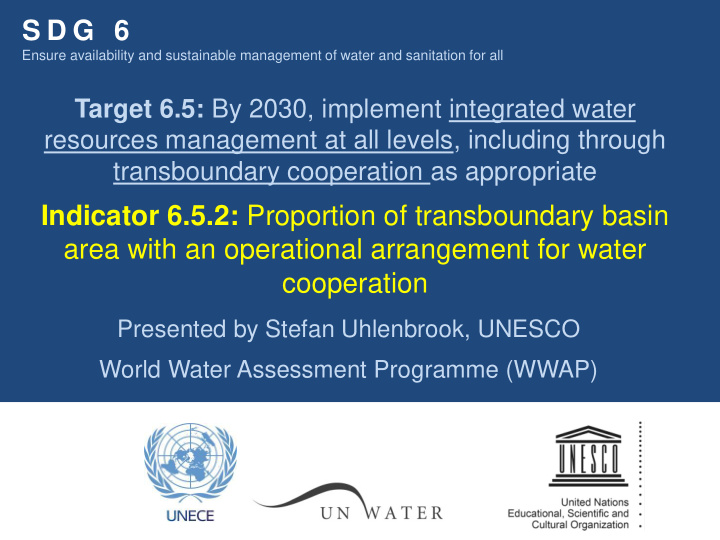



S D G 6 Ensure availability and sustainable management of water and sanitation for all Target 6.5: By 2030, implement integrated water resources management at all levels, including through transboundary cooperation as appropriate Indicator 6.5.2: Proportion of transboundary basin area with an operational arrangement for water cooperation Presented by Stefan Uhlenbrook, UNESCO World Water Assessment Programme (WWAP) Custodian logo(s)
6.5.2: Proportion of transboundary basin area with an operational arrangement for water cooperation Transboundary River basins (TWAP) Transboundary Aquifers (TWAP) • 60% of global freshwater • 286 transboundary river basins • 592 transboundary aquifers Custodian logo(s) 2
Clear Methodology for 6.5.2 a 1 + a 2 + a 5 10 + 10 + 1 = = a 1 + a 2 + a 3 + a 4 + a 5 10 + 10 + 12 + 1 + 1 21 X 100% 34 = 61.8% a 1 a 2 a 4 a 5 a 3 Operational arrangement No operational arrangement (aquifer) (aquifer) Custodian logo(s)
Proposal: Tier 2 for Indicator 6.5.2 ( custodian agencies: UNESCO and UNECE) • Indicator is conceptually clear and methodology is simple, essentially combining data that is available in all countries • International standards and/or methodologies are available for the data components Basin delineations and surface areas consolidated at the regional/global level; incl. groundwater ‘ Operationality ’ of agreements based on main principles of customary international law (i.e., two UN Conventions); clear criteria; data at countries and global data bases • Roll out is part of GEMI project; other ‘supporting’ projects have been carried out or are ongoing 4 Custodian logo(s)
S D G 6 Ensure availability and sustainable management of water and sanitation for all Thank you Custodian logo(s)
Proposed tier for 6.5.2 (cont’d) Transboundary River basins (TWAP) • Data would be most reliably collected and validated at the national level • Reporting by countries under the Convention on the Protection and Use of Transboundary Watercourses and International Lakes will contribute information for tracking progress • International sources of information can support and complement the information by the countries and allows to have a first baseline / overview. – Transboundary river basin delineations and areas as well as presence of an agreement and of a basin organisation: Global Environment Facility supported Transboundary Waters Assessment Programme Transboundary Aquifers (TWAP) (TWAP) – International Freshwater Treaties Database, Oregon State University – Information about transboundary aquifers : regional inventories of the UNESCO-led Internationally Shared Aquifer Resources Management, database of the UNESCO International Groundwater Resources Assessment Centre (IGRAC); Etc. • GEMI will support testing the methodology and acquiring practical experience of its application in countries Custodian logo(s) 6
Background indicator 6.5.2 • Most of the world’s water resources are shared: transboundary lake and river basins account for 60% of global freshwater. Some 286 transboundary main river basins and 592 transboundary aquifers have been identified. • Development and management of water resources has impacts across transboundary basins and therefore transboundary cooperation is required. However, cooperation is in most cases not advanced. • Specific agreements or other arrangements concluded between co-riparian countries are a key precondition to ensure long-term, sustainable cooperation. Custodian logo(s) 7
Recommend
More recommend